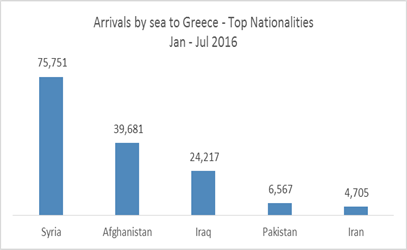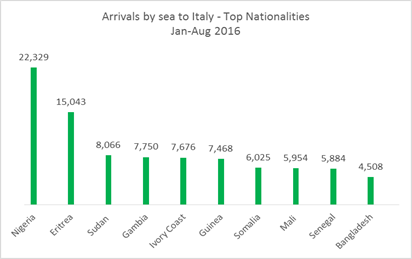-
Who we are
WHO WE AREThe International Organization for Migration (IOM) is part of the United Nations System as the leading inter-governmental organization promoting since 1951 humane and orderly migration for the benefit of all, with 175 member states and a presence in 171 countries.
-
Our Work
Our WorkAs the leading inter-governmental organization promoting since 1951 humane and orderly migration, IOM plays a key role to support the achievement of the 2030 Agenda through different areas of intervention that connect both humanitarian assistance and sustainable development.
What We Do
What We Do
Partnerships
Partnerships
Highlights
Highlights
- Where we work
-
Take Action
Take Action
Work with us
Work with us
Get involved
Get involved
- Data and Research
- 2030 Agenda
Mediterranean Migrant Arrivals Reach 297,039; Deaths at Sea: 3,212
Italy - IOM reports that 297,039 migrants and refugees entered Europe by sea in 2016 through 14 September, arriving mostly in Greece and Italy. Some 165,409 people have arrived in Greece and 129,126 in Italy during 2016.
With thousands of migrants and refugees rescued this week in the Channel of Sicily, IOM expects the total number of arrivals to pass the 300,000 mark this weekend. This figure is far short of the 469,869 arrivals recorded by IOM at this point in 2015.
But deaths of migrants and refugees in the Mediterranean are occurring more frequently this year than in 2015. As of 14 September, 2016, IOM’s Missing Migrants Project reports 3,212 deaths, compared with 2,788 through mid-September 2015 – an increase of approximately 15 percent.
IOM Rome spokesperson Flavio Di Giacomo reports that in the latest round of sea rescues this week, five corpses were recovered and are expected to be brought today (16/9) to the Italian port of Augusta. One victim is said to be an expectant mother.
Missing Migrants Project’s Julia Black notes that the pattern of sea deaths this year shows some divergence from that of 2015. “By this time last year we reported just 24 deaths on the Western Mediterranean route linking Africa to Spain. This year we are at more than double that total – 61 deaths – despite very little difference in the total number of arrivals,” she noted.
On the Eastern Mediterranean route linking Turkey and Greece, deaths this year stand at 386 – over double the 175 fatalities recorded through mid-September last year. This is despite the fact that the total number of arrivals through 15 September 2015 was more than double 2016’s mid-September total.
One explanation could be the different seasons: the bulk of 2015’s Turkey-to-Greece arrivals occurred during summer months, when seas are calmer. The majority of this year’s sea arrivals to Greece came during the 11 weeks between January 1 and 20 March.
In 2016, IOM reports that on the Central Mediterranean passage linking Libya and Italy the death toll was also higher than at this time last year. Through 14 September 2016, the Missing Migrants Project reports 2,765 drowned or missing, compared with 2,614 in 2016, an increase of 6 percent.
One possible explanation may lie in the changing demographics of people traveling on these routes. As the chart (below) shows, this route has seen a sharp drop in travellers from Syria and Eritrea – two major countries of origin in 2014 and 2015.
IOM’s Flavio Di Giacomo reports that Italian authorities have recorded just 577 Syrian arrivals in 2016, compared to around 7,000 through 2015. Arrivals of Eritreans have fallen to 15,043, compared with 31,080 through the first eight months of 2015. The number of Somalis has also fallen by almost 3,000, and the number of Bangladeshis by about 500.
At the same time there has been a sharp increase in the number of Nigerians (+6,998), Ivorians (+5,041), Guineans (+6,010), Gambians (+2,053) Malians (+1,755) and Senegalese (+1,652).


IOM Athens reports that 1,572 migrants and refugees landed on Greek islands through the first 14 days of September – a daily average of 112 men, women and children. That number is consistent with the daily average number of arrivals during August, when 3,429 migrants and refugees entered Greece by sea.
Radoslav Stamenkov, the head of IOM’s office in Sofia, Bulgaria, reported this week that six Iraqi nationals drowned while trying to cross the Danube – the border between Bulgaria and Romania – on the night of 8/9 September, according to Bulgarian border police. Four of the dead were children.
Another four migrants – part of the same group – managed to reach the small island of Dobrina on the Bulgarian side of the Danube, where they were rescued by a border police patrol. The incident occurred close to the village of Archar on Bulgarian territory, located in the far northwest of the country, not far from the border with Serbia.
All ten migrants are said to have boarded one of two boats, which they abandoned when it started sinking. Survivors told police that the smugglers were two individuals wearing balaclava masks. When the migrants’ boat began sinking, the smuggler accompanying them abandoned them, jumping into the second boat.
Police were initially alerted by a Bulgarian fisherman who heard the migrants screaming for help shortly before midnight on 8 September. Romanian border police also were alerted and participated in the search for the missing migrants.
On 11 September divers discovered the bodies of a 5-year-old child and 22- or 23-year-old male. A third body was found 40 km downstream of the incident.
According to police, the migrants paid between USD 7,000 per child and USD 10,000 per adult to be smuggled from Iraq to Germany. This is the first registered attempt to irregularly cross the Danube in three years.
IOM Bulgaria indicated the accident may mark the emergence of a sub-corridor along the Eastern Mediterranean route. Serbian border police and military have strengthened surveillance and patrols on the border with Bulgaria.
IOM Bulgaria reports that 13,005 undocumented migrants have been identified in Bulgaria in 2016. Some 7,635 were detected when trying to exit the country, suggesting that most of the arrivals are in transit and do not see Bulgaria as their final destination.
“In a majority of cases they leave via the Serbian border. But many people remain stranded in Bulgaria or in neighbouring Balkan transit countries for months, often in a vulnerable situation and dependent on smugglers to arrange their travel,” noted Stamenkov.
In 2015, 20,391 migrants and refugees registered asylum applications in Bulgaria – nearly double the 2014 total. In 2016 through 30 July there were 9,388 new asylum applications. The top countries of origin were: Afghanistan (47 percent), Iraq (30 percent) and Syria (11 percent).
http://missingmigrants.iom.int/sites/default/files/Mediterranean_Update_16_September_2016.pdf
For latest arrivals and fatalities in the Mediterranean, please visit: http://migration.iom.int/europe
Learn more about Missing Migrants Project at: http://missingmigrants.iom.int
For further information please contact:
Flavio Di Giacomo at IOM Italy, Tel: +39 347 089 8996, Email: fdigiacomo@iom.int
IOM Greece: Daniel Esdras, Tel: +30 210 9912174, Email: iomathens@iom.int or Kelly Namia, Tel: +30 210 9919040, +30 210 9912174, Email: knamia@iom.int
Julia Black at IOM GMDAC, Tel: +49 30 278 778 27, Email: jblack@iom.int
Mazen Aboulhosn at IOM Turkey, Tel: +9031245-51202, Email: aboulhosn@iom.int
Joel Millman at IOM Geneva, Tel: +41.79.103-8720, Email: jmillman@iom.int
IOM Libya: Othman Belbeisi, Tel: +216 29 600389, Email: obelbeisi@iom.int or Ashraf Hassan, Tel: +216297 94707, Email: ashassan@iom.int
Radoslav Stamenkov at IOM Bulgaria, Tel: +359 886 177 053; Email: rstamenkov@iom.int
For information or interview requests in French:
Florence Kim, OIM Genève, Tel: +41 79 103 03 42, Email: fkim@iom.int
Flavio Di Giacomo, OIM Italie, Tel: +39 347 089 8996, Email: fdigiacomo@iom.int
